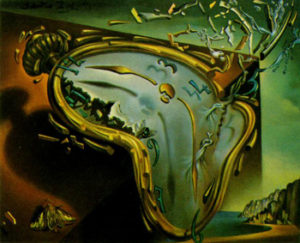 (Illustration by Arne Dedert/Picture, Alliance/Getty Images, and found here).
(Illustration by Arne Dedert/Picture, Alliance/Getty Images, and found here).
Despite some decent news today at the COP26 gathering in Glasgow, Scotland, the end results of this UN conference on climate change is up in the polluted air with a draft agreement looking good now, but shitty later — from The Washington Post this afternoon:
The explicit reference to coal and fossil fuels — a first for any U.N. agreement — was a welcome breakthrough for most activists. And the proposal to speed up emissions reductions was seen as a necessary response to recent research showing that current pledges put the Earth on path to warm 2.5 degrees Celsius (4.5 degrees Fahrenheit), a full degree above the Paris agreement’s most ambitious goal.
But both provisions could get watered down, or eliminated entirely, as diplomats huddle behind closed doors to shape an agreement all 196 countries would sign.
Outside the negotiating rooms, disappointment with the draft’s climate finance provisions dominated many discussions Wednesday
Just to kind of edge these people on, another fricking study was published today at Nature, showcasing our current unique environmental situation — we’ve gained a shitload of excess heat in a comparatively short span of time.
From the Abstract: ‘In contrast with previous proxy-based reconstructions our results show that global mean temperature has slightly but steadily warmed, by ~0.5?°C, since the early Holocene (around 9 thousand years ago). When compared with recent temperature changes our reanalysis indicates that both the rate and magnitude of modern warming are unusual relative to the changes of the past 24 thousand years.‘
This is not a drill:
The Earth is warming at rates not seen in at least the last 24,000 years, according to a new study. @HughesRosana https://t.co/GGVWLsZIf9
— Courthouse News (@CourthouseNews) November 10, 2021
Details via Courthouse News Service:
Using temperature data from marine sediments and computerized climate simulations, researchers at the University of Arizona led an effort to reconstruct the Earth’s climate since the last ice age, or about 24,000 years ago.
The findings illustrate just how far out of bounds human-driven global warming is pushing the climate system.
“This reconstruction suggests that current temperatures are unprecedented in 24,000 years, and also suggests that the speed of human-caused global warming is faster than anything we’ve seen in that same time,” Jessica Tierney, study co-author and geosciences associate professor at the University of Arizona, said in a statement.
Tierney has contributed to the Intergovernmental Panel on Climate Change reports and climate briefings for the U.S. Congress.
“The fact that we’re today so far out of bounds of what we might consider normal is cause for alarm and should be surprising to everybody,” lead study author Matthew Osman, geosciences postdoctoral researcher at the University of Arizona, said in a statement.
The clincher: It also shows that the global mean temperature has slightly but steadily warmed by about half-a-degree Celsius in the past 9,000 years, and that the magnitude and rate of warming over the past 150 years has far surpassed that of the last 24,000 years.
Nothing heavy!
And contextual in a global-warming life, another study on the texture of urban areas, a magnetic-tinderbox for heat. The research was published early last month at the Proceedings of the National Academy of Sciences (PNAS), and again, from the Abstract: ‘Our results suggest that previous research underestimates extreme heat exposure, highlighting the urgency for targeted adaptations and early warning systems to reduce harm from urban extreme heat exposure.‘
Deep-dive details at The Washington Post yesterday — a must-read for the whole piece, as it goes into intense particulars of how this escalating warmth with cities will affect mankind. Including this terrible one-paragraph nutshell: ‘By late century, billions of people could be experiencing annual average temperatures now found only in the world’s hottest cities, such as Bangkok, and heat on some days could reach virtually unsurvivable levels in a growing number of locations.‘
Not a nice ending.
Yet once again, here we are…
 (Illustration out front: Salvador Dali’s ‘Soft Watch at the Moment of First Explosion,’ found here).
(Illustration out front: Salvador Dali’s ‘Soft Watch at the Moment of First Explosion,’ found here).